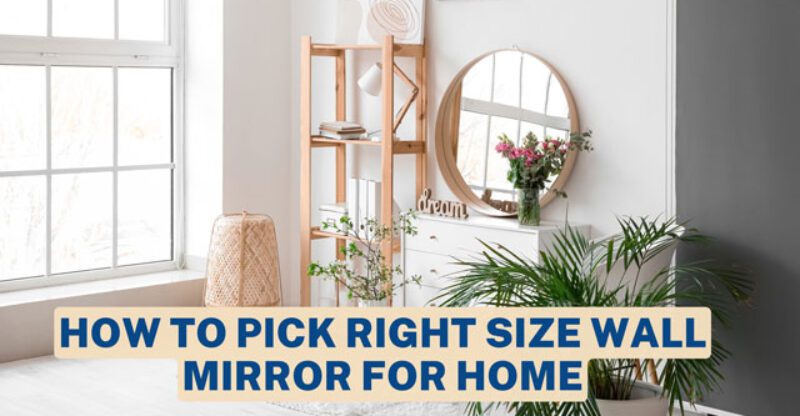How to Pick the Right Size Wall Mirror for Home
Are you looking for the perfect right-size wall mirror to complete your home decor? Picking the right size wall mirror for your home can be a tricky task.
It’s important to get the size just right to achieve the desired look and effect. Whether you’re looking to create a statement piece or fill an empty space.
It’s important to consider several factors such as the size and shape of the room, the overall style of the space, and your own personal style. The right size wall mirror can make a big impact on the look and feel of your home, so it’s important to pick the right one.
In this blog post, we’ll discuss the key factors to consider when selecting the perfect wall mirror for your home.
What to Consider When Choosing a Wall Mirror
When choosing the right size wall mirror, there are a few factors to keep in mind:
- A shape that works for you
- Size of the mirror itself
- Style of the mirror in the room
- Budget required
- Matching with existing decor
Why Do Shape, Size, and Style Matter?
A Shape, size, and style of a wall mirror matter because:
Shape
Shape Matters in Choosing Your Wall Mirror. The shape of your mirror can greatly impact the feel of a room. Long horizontal shapes create a feeling of width, while tall vertical shapes bring a sense of height.
Angular shapes like squares and rectangles bring order, and rounded or curved frames add a touch of softness. You can even use multiple mirrors to create a unique shape in your space. Don’t underestimate the power of shape in choosing the perfect wall mirror for your home.
Size
The size of the mirror is a crucial factor in how it will impact the look and feel of your room. A larger mirror will reflect more of the room, creating an illusion of spaciousness, while a smaller mirror will reflect less of the room and blend into the background.
It’s important to consider the size of the wall space you have available and choose a mirror that will complement the scale of the room and other furniture pieces.
When choosing the right size mirror, it’s also important to consider the purpose of the mirror, whether it will be decorative or functional, and what type of activity will take place near it.
A mirror that’s too small for a space will look out of proportion, while one that’s too large can overpower the room.
Common Standard Mirror Sizes
- 24″ x 36″: This is a versatile size that works well in most spaces, including bathrooms, bedrooms, and hallways. It’s also a common size for full-length mirrors, providing a good view of the entire body.
- 30″ x 40″: This is another popular size that works well in many spaces. It’s a good choice for a medium-sized wall and provides a good amount of reflection.
- 36″ x 36″: This square shape is a great choice for creating a focal point on a wall. It works well in contemporary or modern-style rooms.
- 36″ x 48″: This is a large size that works well in larger spaces such as living rooms, dining rooms, or entryways. It provides a good amount of reflection and helps make a space feel larger.
- 42″ x 42″: This square size works well in medium to large-sized rooms. It creates a bold statement and provides a good amount of reflection.
- 48″ x 48″: This large square size works well in larger spaces and creates a strong visual impact. It’s a good choice for creating a focal point on a wall.
- 36″ x 60″: This is a large size that provides a significant amount of reflection. It works well in larger spaces such as living rooms, dining rooms, or entryways.
- 48″ x 72″: This is a very large size that provides a significant amount of reflection and creates a bold statement in any space. It’s best used in large, open spaces where it will have room to shine.
It’s important to note that these are just a few of the most common standard mirror sizes available. Custom-cut mirrors can also be made to fit specific wall spaces, giving you even more flexibility in choosing the right size for your home.
Style and Aesthetic Considerations
When choosing a wall mirror for your home, it’s important to consider the style and aesthetic of the room in which it will be placed. This means considering the decor and furniture already present in the space, as well as the shape and frame of the mirror itself.
A mirror that complements the existing elements in a room will help create a cohesive and harmonious look. When it comes to the frame, there are many options to choose from. A mirrored frame can add an elegant touch, while a simple metal frame can create a more contemporary look.
A shaped frame, such as an ornate or scalloped edge, can add an antique feel to the room. Ultimately, the style and aesthetic of the room should dictate the style of the mirror that is chosen to enhance the overall look and feel of the space.
The Different Types of Mirrors
The different types of mirrors include:
- Standard Mirrors: These are simple, clear mirrors that are widely used in homes and other spaces.
- Decorative Mirrors: These mirrors are designed to add a decorative element to a room and are often framed or embellished in some way.
- Wall-Mounted Mirrors: These are mirrors that are mounted directly onto a wall, and are often used in bathrooms, bedrooms, and hallways.
- Floor Mirrors: These are large mirrors that stand on the floor and are often used in bedrooms and dressing rooms.
- LED Mirrors: These are mirrors that are illuminated by LED lights, and are often used in bathrooms, bedrooms, and vanity areas.
- Dressing Mirrors: These are mirrors that are mounted on a stand or attached to a closet door and are often used for getting dressed or doing makeup.
Estimated Budget Required for wall Mirror
The estimated budget required for a wall mirror can vary greatly depending on several factors, including the size, type, and style of the mirror.
Standard mirrors can be purchased for as little as $20-$50, while more elaborate decorative mirrors can cost several hundred dollars or more.
LED mirrors tend to be more expensive due to the added lighting features, with prices ranging from $100-$500 or more.
Floor mirrors can also range in price, with basic models starting around $100, larger, and more decorative options costing several hundred dollars or more.
It’s important to consider your budget when choosing a wall mirror and to look for the best quality options within your price range to ensure that you get a durable and long-lasting product.
Rules for Hanging Mirrors
When hanging a wall mirror, there are several important rules to follow to ensure that the mirror is securely and safely mounted:
Make sure that you use the proper hardware for hanging the mirror, based on its size and weight. Consider using toggle bolts for heavy mirrors, as these provide a strong and secure hold.
Decide on the best location for the mirror, taking into consideration any electrical outlets, windows, or other obstacles that may impact the placement.
Measure the distance between the hanging hardware and the center of the mirror and mark this measurement on the wall. This will help you determine the proper placement of the hanging hardware.
Use a level to make sure that the mirror is straight and even when hanging. After hanging the mirror, give it a gentle push to make sure that it is securely attached and does not wobble.
Hang the mirror at a height that is comfortable for viewing, typically at eye level or slightly above. Hire a professional: If you are not confident in your ability to safely hang the mirror, consider hiring a professional to do the job for you.
Conclusion
The right size wall mirror can greatly enhance a room, creating a balanced and stylish look. It is important to carefully consider the factors mentioned above and choose a mirror that best fits your needs and preferences.
A well-chosen wall mirror can serve as both a functional piece and a decorative accent in any home. We hope that this blog post has helped you find the perfect mirror for your home.
FAQs
The best height for a wall mirror is typically at eye level or slightly above, around 5’6” to 5’9”. This ensures comfortable viewing and a pleasing aesthetic.
Bigger mirrors are not necessarily better, it depends on the space and desired look. A larger mirror can make a room appear bigger, but it also needs to be proportionate to the room and its furniture. Choose a size that balances the room and fits well with the surrounding decor.
To determine the right size mirror for an entryway, consider the size of the wall and the scale of the surrounding furniture. A mirror that is proportional to the wall and furniture will create a balanced look. If space allows, a full-length mirror is a practical choice. For a smaller entryway, a smaller mirror can still make a stylish statement.



